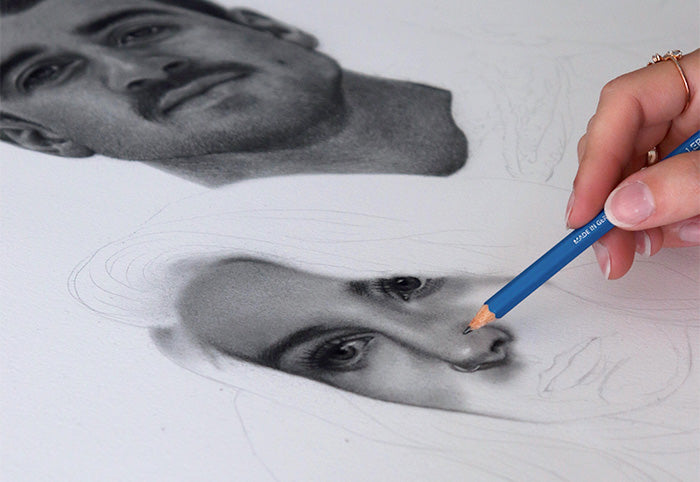Article written by : Laura Restrepo
A pencil is the most immediate, common and sensitive tool in the world of drawing. With it, we artists, have been able to create quick and spontaneous sketches, or highly elaborated artworks for centuries. In fact, since a very young age, we all learn how to hold a pencil to write or illustrate an idea; however, this simple tool can offer us so much more if we only take the time to explore it and to understand it. In that spirit, I am extremely happy to share with you some little tips and facts that have helped me to develop the quality of my pencil drawings throughout the years.

Laura Restrepo
Graphite pencils
Most pencils (graphite and charcoal) are classified in a rich spectrum ranging from “H” (hardness) to “B” (blackness). The regular writing pencil is graded HB, while the lightest is 9H and the darkest is 9B. This variety is perfect to easily create a vast range of values, from the lightest details to the darkest shadows.
I find that working in layers creates a smooth and close-to-reality transition. Therefore, I start every artwork by tracing some subtle lines with my HB pencil, and then applying delicate layers of graphite with my 2B, 4B, 6B, 8B, and sometimes 9B pencils. Working always on the lightest areas first, and then finishing with the strongest contrasts.
Also, I have learned that once my drawing is completed and I see some areas where the transitions of light and shadow are not as seamless as expected, I can always go over it and correct it by applying a fine layer of H or 2H graphite pencil. You will observe that this extra layer will magically fuse the transitions in the selected area of the drawing.
In addition, one of the greatest advantages of graphite pencil is its reversibility. If you consider that your drawing is too dense or opaque, you can use an eraser and create some points of light. In fact, I enhance most of the textures in my drawings by increasing the lightest values using a pencil eraser in small areas, or a regular eraser in larger zones.
A last little tip for those who (like me) are obsessed with the smoothness in the transition of light and shadow – add a soft brush to your essentials! This additional tool will help you smudge graphite or charcoal. It is without a doubt a great way to improve the fusion of layers in your drawing, without damaging the natural fibre or grain of the paper.

Charcoal pencils
Now, if you are familiar with the basic principles of graphite pencil, charcoal will be an exciting option for you!
With charcoal pencils, you will obtain high contrasts without the reflecting effect of graphite. Your black areas will be beautifully matte and significantly darker. Also, this versatile medium will surprise you by producing wonderful textures on a variety of surfaces, or even extremely soft finishes.
I follow the same layering rule when I’m working with charcoal (pencil and powder). I start by applying a light layer on my paper to roughly define the shape of the face, body or object. From there, I work little by little on adding values, details and textures with my charcoal pencils, which are ranged from HB to 8B.
It is important to mention that there are multiple techniques that you can explore with this ancient medium, such as hatching, rubbing, blending, lifting (erasing), etc. There is no limitation for your creativity. You only need to find your aesthetic and adopt the technique that represents you the most. For example, even if many artists use their fingers to blend the different layers of charcoal, I realized that this approach did not work for me. The natural oil that is always present on my skin interferes with the soft transitions that I want to create. So, I strongly avoid touching my paper – and when it comes to fusing the many shades of grey, I stay with my traditional brush.








